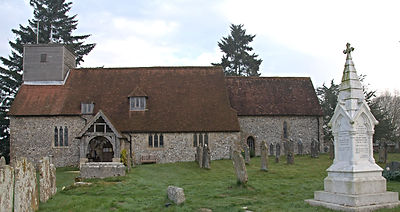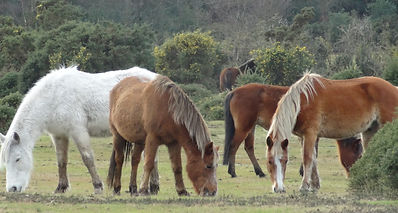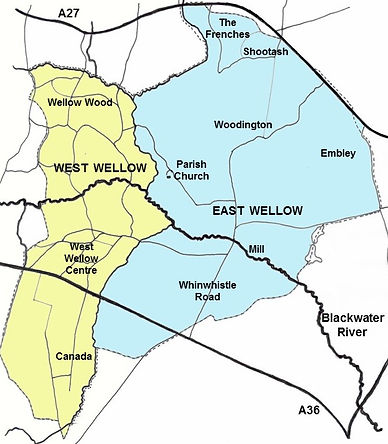
New Forest ponies on West Wellow Common


Wellow History Society

St. Margaret's Parish Church with the Nightingale family memorial
New Forest ponies on West Wellow Common
Situation
The parish of Wellow is situated about 4 miles (6 km) west of Romsey and almost half way between Southampton and Salisbury, with its western fringes in the New Forest National Park of south-west Hampshire (see map on Contact Us page). It straddles the River Blackwater, a major tributary of the River Test, at the entrance to the Blackwater valley. The land of the village rises to the north to a ridge which separates the main Test valley from the Blackwater valley, and rises less steeply to the south where its margins lie within the New Forest National Park. The main villages of East and West Wellow lie between two former turnpike roads, now known as the A27 to the north and the A36 to the south.
With an area of some 3870 acres (nearly 1570 hectares) of fields and woods, it has had a largely agricultural history. The best agricultural land is to the north of the river; towards the south it tends towards heathland. The Common land at the south-west of the village connects with the New Forest, and is accessible to free-ranging ponies and cattle from the Forest.

Wellow Parish’s present population of about 3,500 has more than doubled since the end of World War II, following the improvement in services and the use of cars to commute to neighbouring towns for work. It is now part of Test Valley Borough and is bordered by six other parishes.
Early History
Wellow has existed since Anglo-Saxon times, first appearing in recorded history in the will of Alfred the Great, King of Wessex, written in about AD 880, in which he left Welewe to his eldest daughter Æthelfleda:
Translated as:
Note:
Some 50 years later on 15 July 931 Alfred’s grandson Æthelstan, first King of all England, held a Witan (a royal council) in his "royal vill" of Welowe.
In the Domesday Book there are separate entries for Embley and for the main part of Wellow. Welewe had been left in the hands of an Anglo-Saxon (Ægemund) who had previously been answerable to Edward the Confessor, except for a part of East Wellow named Emele (later Emly or now Embley) which was put into the hands of a Norman. The Welewe entry records that shortly after the Norman Conquest, the village was split into two with West Wellow being transferred to Wiltshire whilst East Wellow remained within Hampshire.
The whole of Wellow has remained a single ecclesiastical parish since Saxon times, although divided for more than eight centuries into two civil parishes in different counties.

Development of the Village
During the Stone Age and Bronze Age nomadic people who had lived in the area for many centuries began to clear areas of woodland and settle down to grow crops and domesticate animals. By Anglo-Saxon times fields and farmsteads developed in Wellow near to the Blackwater and on the better soils to the north, producing a scattered farming community.
One larger farm developed as the Manor Farm, and adjacent to this the Parish Church was built near the centre of Wellow. In common with many other agricultural villages in the area Wellow remained a community of scattered farmsteads and did not become a “nucleated” village until the late 18th and early 19th centuries when tradesmen settled around shops near the centre of West Wellow gradually replacing itinerant traders. Contrary to published statements there is no evidence for a concentration of medieval dwellings near the Church. Agricultural workers lived on the farms and later in several hamlets that grew up at the edges of common land.
Land Ownership
For much of recorded history the three sections of East Wellow, West Wellow and Embley have developed separately, although they do share the 13th century Parish Church of St Margaret of Antioch, the oldest surviving building in Wellow. This is a manorial church built beside the Manor Farm of East Wellow and remote from the main centres of population.
Early in the 13th century the church, most farms in East Wellow and one or more of those in West Wellow were given to support the foundation and continuance of Netley Abbey, near Southampton. This relationship continued for almost three centuries until the dissolution of the monasteries by King Henry VIII and in 1536 their farms became the property of the crown until 1544 when they were sold to swell the coffers of the King. The lords of the manor retained patronage of the church until it passed to the Bishop of Winchester in the late 1920s.
In the following decades the estate gradually separated into different parts by inheritance, but in the late 17th century the parts were individually bought by members of the Norton family of Southwick, and William Norton became lord of the manors of East and West Wellow. In 1712 these manors were sold to James Brydges, later made Duke of Chandos, whose family retained control for a century.
Embley had remained under separate ownership throughout this time. By the middle of the 18th century it comprised a single estate owned by John Thorpe. John’s daughter married Sir William Heathcote, heir to the estates of Hursley, and after John died the estate passed into Heathcote control. Sir William Heathcote bought the manors of East and West Wellow from the Chandos family, so that the whole of East Wellow (including Embley) and several farms in West Wellow formed part of one large estate.
After the death of Sir William’s son Sir Thomas Heathcote in 1825 the estate was sold to William Edward Nightingale, the father of Florence Nightingale, Wellow’s most famous personality. The Nightingale family sold the estate in 1895 and in 1920 many of the farms were sold to individual farmers in an estate sale.
The Embley estate contracted further in 1942 in a second estate sale, when the final farms were sold.
Inclosure Acts
No details are known of the results of the East Wellow Inclosure Act of 1730, but the whole parish was already owned by the Duke of Chandos. The 1809 West Wellow Inclosure Act was different because it divided the areas of common land among a large number of smaller landowners and left a substantial area of common land which remains today as West Wellow Common. Over the years the land of Wellow has progressively passed from large landowners into the hands of many individual farmers, only for this process to be reversed in recent years.
Population
We can only guess at the size of the population of Wellow before the first national census was held in 1801. At this date the total population was 602, made up of 257 in East Wellow and 345 in West Wellow.
Since 1801 the population has mostly grown steadily, except for two significant periods. During the first, between 1851 and 1871 the population grew from 704 to 946, largely because of the development of the Canada area in West Wellow. In the 19th century the village was largely self-sufficient with diverse agriculture and market gardening, and had a large diversity of shops, tradesmen and occupations.
The connection of Wellow houses to mains electricity and water supplies in the early 1950s made little difference to the population growth, but between 1961 and 1981 the population grew from 1618 to 3221 following the construction of a sewage treatment works which allowed higher density housing on estates in both East and West Wellow.
Now, as a result of increased mobility, a high proportion of residents travel to do their shopping and work outside the village. A small cluster of shops is situated near the main road in West Wellow, with a Village Hall and recreation grounds for cricket, football and tennis not far away. Wellow golf course has been laid out adjacent to Embley Park.
Administration
Until the mid-19th century the parish officers dealing with such matters as poor relief and roads were elected members of the two Parish Vestries within the separate counties of Wiltshire and Hampshire. West Wellow was reunited with Hampshire in 1895 and the civil functions of the vestries were transferred to elected Parish Councils for East and West Wellow, but they did not amalgamate to form a single Parish Council for the whole of Wellow until 1932.
Today, many parish matters are still dealt with by the Parish Council, but larger issues are administered by the Test Valley Borough Council or Hampshire County Council.
Education
There have been several private schools in Wellow, but two principal schools for the education of village children. The first was started by Mr Nightingale in 1828 in a building he provided next to Warners Farm in East Wellow. After the 1870 Education Act a formal School Board was set up and it was clear that a larger school was needed. A new building was erected on a site provided by Mr Nightingale and opened in 1875. This initially provided the only education for local children, but with the extension of the duration of schooling it became a primary school. It still serves Wellow and surrounding villages today with children moving on to secondary schools in the surrounding areas of Romsey, Southampton and Salisbury.
After the Second World War a private boarding school was started at Embley House in Embley Park, for boys from 11-18 and housed in the former mansion of the Nightingale family where Florence Nightingale grew up. After several transformations and mergers it was known as Hampshire Collegiate School until September 2019 when it was decided to rename it Embley.
